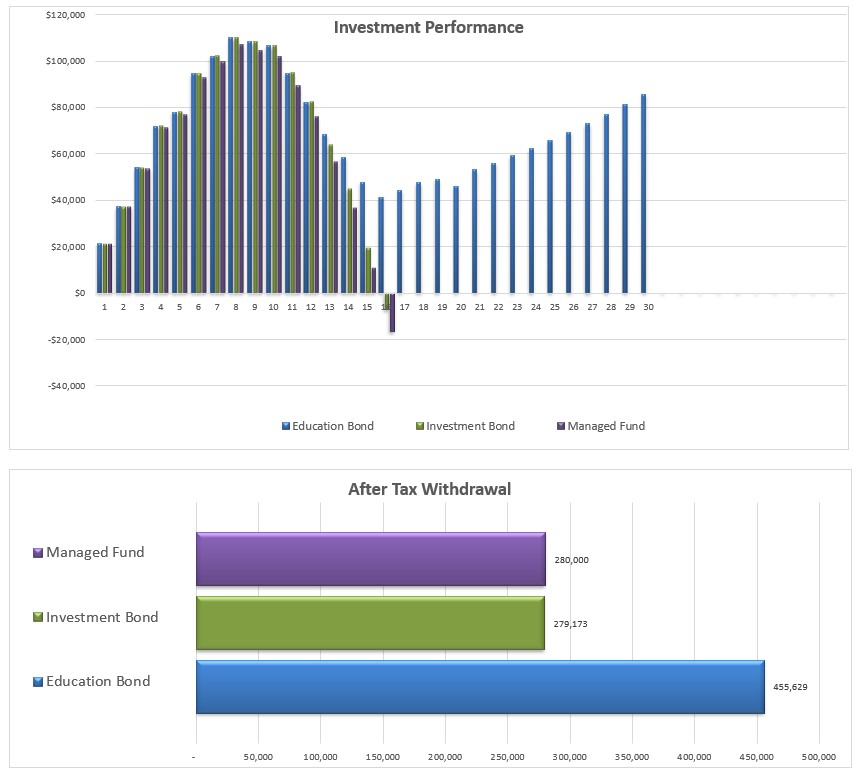Investment & Education Bonds
Investment and education bonds may help you meet the twists and turns of life and your long-term investment goals in a number of ways:
- tax-effective benefits for wealth creation and the generational transfer of that wealth
- goal-specific and flexible investment solutions for different life stages
- an investment solution with greater choice and control on ‘what’, ‘how much’ and ‘when’ to invest
- complete flexibility to access your investment at any time
- asset protection
What is an investment bond?
An investment bond is a long term investment with features similar to a managed fund combined with an insurance policy.
Your money is pooled with money from other investors and a portion of the pooled funds is then invested in the investment options each investor chooses.
Most investment bonds offer investment options such as cash, fixed interest, shares, property, infrastructure or a range of diversified investment options, with risk levels ranging from low risk to high risk. The value of the investment bond will rise or fall with the performance of the underlying investments.
You have access to your investment at any time, including before 10 years. If you make a withdrawal before 10 years, you will receive a compensating tax offset (currently 30%) which you can use to offset any personal tax payable in the financial year that the withdrawal was made.
What is an education bond?
An Education Bond is a dedicated, tax effective investment for education, but can also be used for other purposes. It can be for yourself but most people use an Education Bond to invest in the future of their children or grandchildren.
Offering all the features of an Investment Bond, an Education Bond also has special Education Tax Benefits, Estate Planning features and the discretion to appoint multiple Beneficiaries. Some of the unique characteristics of an education bond include:
Tax free contributions – money paid into the Education Bond doesn’t attract any tax and can be accessed at any time.
30% Education Benefit – The bond provider pays tax on the bond’s ongoing investment earnings at a tax rate of up to 30 percent on your behalf. When you make a withdrawal to fund education, you’ll enjoy a refund of the tax paid, which gives you an extra $30 for every $70 dollars withdrawn.
Access Capital tax free – Any withdrawals sourced from your Bond’s Capital Component will be tax free. Your Capital Component comprises your Contributions made from money you have already personally paid tax on or are capital sums.
Estate Planning
When an investment bond is set up, you’ll need to nominate a policy owner, a life or lives to be insured and beneficiaries. The policy owner may be the same as the life insured.
If the last insured person passes away, the beneficiary receives the proceeds from the insurance bond tax free. If there is no nominated beneficiary, the proceeds will go to the policy owner or the policy owner’s estate.
Most investment bonds also offer a child advancement policy where ownership of the policy is able to be transferred to a child when they reach a nominated age. This can be a tax effective way to save for a child’s future and depending on the investment bond established, can provide some benefits akin to Testamentary Trusts established within an estate plan.
If you are considering using investment bonds for estate planning, seek professional legal advice first.
The 10 Year Rule
Investment bonds are tax paid investments. This means when earnings on the investment are received by the insurance company, they are taxed at the corporate tax rate (currently 30%) before being reinvested in the bond. This can make insurance bonds a tax effective long term investment for those with a marginal tax rate higher than 30%.
If you hold the bond for at least 10 years the returns on the entire investment, including additional contributions made, will be tax free subject to the 125% rule.
If you make a withdrawal within the first 10 years, the rate at which earnings in the investment bond are taxed will depend on when you make the withdrawal.
The 125% Rule
An investment bond is designed to be held for at least 10 years. You can make additional contributions over the life of the insurance bond. To make the most of the tax benefits, each year you can contribute up to 125% of your previous year’s contribution.
If contributions are made to the investment bond that exceed 125% of the previous year’s investment, the start date of the 10 year period will reset to the start of the investment year in which the excess contributions are made. You will then have to wait a further 10 years from this date to gain the full tax benefits.
Furthermore, if you do not make a contribution to the investment bond in one year, any contributions in following years will reset the 10 year rule.
Case Study
Combining the characteristics of an Investment Bond with the innovation of an Education Bond, the below Case Study illustrate how it works.
Assumptions
- $6,000 initial contribution
- regular contributions of $1000 per month
- MTR 39%
- Projected return 8.5%
Strategy
- Build capital account over the next few years before the kids (Age 5, Age 3 & Age 1.5) go to high school
- Withdraw $10,000 from capital (tax free) in 5 years for a family holiday
- Withdraw $10,000 from capital (tax free) every year for each child throughout high school
- Withdraw $15,000 from earnings (and receive 30% gross-up equalling $4,500) for each child between age 18 -21 for tertiary studies, or to reimburse for school expenses already incurred.
- Withdraw the final balance as a traditional tax paid investment bond.
Outcome

Source:
Money Smart ASIC
Futurity Investment Group




